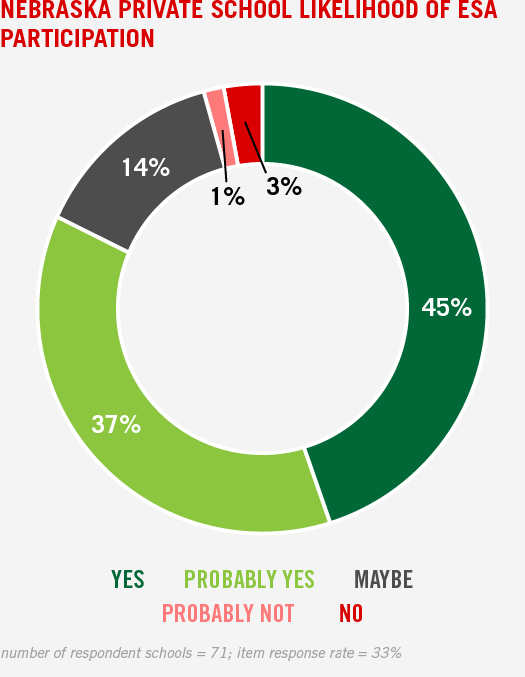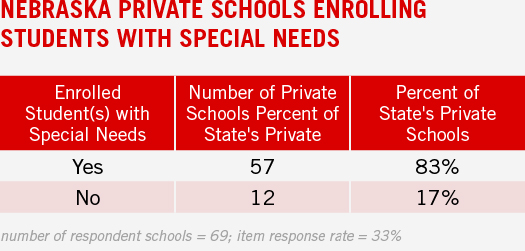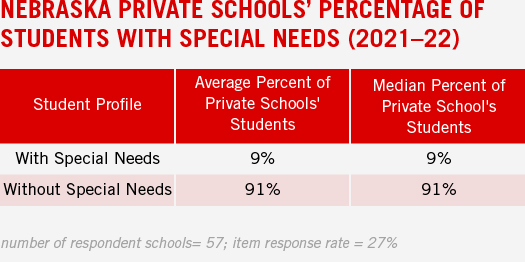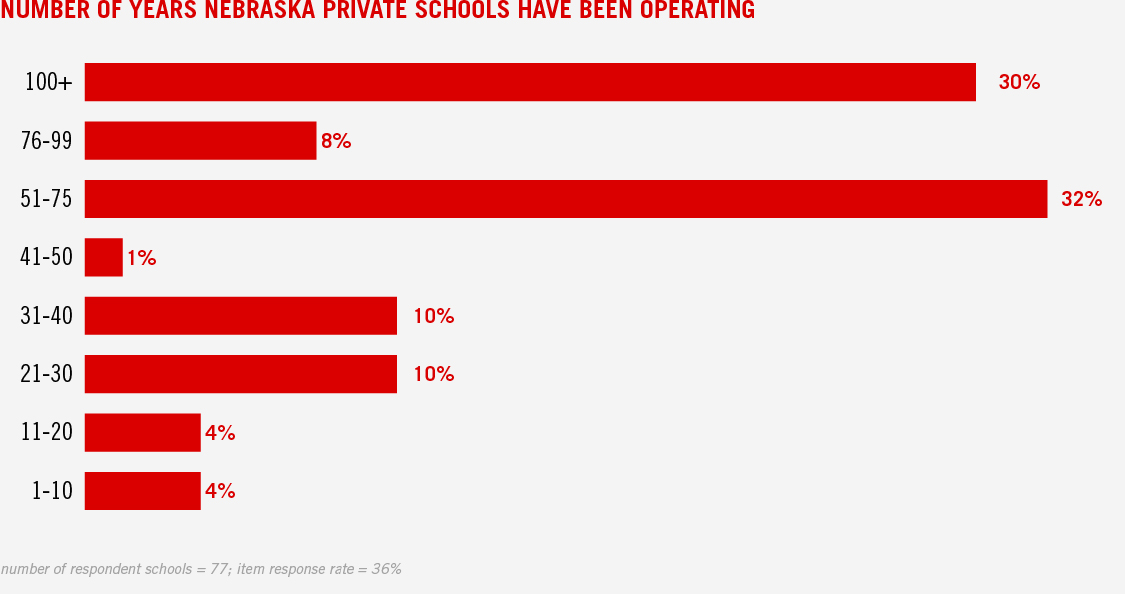Key Findings
- Private schools in Nebraska have at least 5,500 open seats available.
- Thirty-seven percent of private schools were already familiar with education savings accounts (ESAs) before taking the survey. Fifty-four percent of them already knew about tax-credit scholarships (TCSs).
- Eighty-one percent of private schools said they would likely participate in an ESA program if they were eligible.
- No one regulatory item dominates private schools’ concerns about government regulation, as each regulatory area presented was labeled a concern by less than half of all responding private schools. The most frequently named concerns were accommodations for students with special needs, reporting, testing, and curriculum.
- Nearly all (96%) of private schools annually administer at least one nationally norm-referenced test.
- Eighty-three percent of private schools currently serve children with special needs. Based on schools’ responses, an estimated 8.9 percent of private school students in Nebraska have special needs.
Overview
Revisiting Nebraska’s Private Education Sector synthesizes information about Nebraska’s private schools from a survey conducted by EdChoice.
Nebraska does not currently have any private educational choice programs, but recent legislative pushes have brought options such as education savings accounts (ESAs) into the spotlight.1
ESAs allow parents to withdraw their children from public district or charter schools and receive a deposit of public funds into government-authorized savings accounts with restricted, but multiple, uses. Those funds — often distributed to families via debit card — can cover private school tuition and fees, online learning programs, private tutoring, community college costs, higher education expenses and other approved customized learning services and materials. Some ESAs, but not all, even allow students to use their funds to pay for a combination of public school courses and private services. Six states have ESA programs, although one of those state programs is currently inactive.2
The characteristics of Nebraska’s private school sector can inform policy debates surrounding the potential creation of educational choice programs, such as ESAs. From March 31 to May 23 2022, EdChoice administered a survey of Nebraska private school leaders. This brief provides a descriptive analysis of the results of that survey, including tuition and fees, the number of open seats, regulatory concerns, and interest in educational choice programs. This report follows another survey of Nebraska private school leaders that EdChoice conducted in 2015, which received responses from 105 private schools.3 Considering the gap between the two surveys, this report could provide insight into long-term changes in Nebraska’s private education environment.
Do Nebraska’s private schools have available seats for new students?
Of the schools taking part in the EdChoice Nebraska survey, cautious estimates show the state’s private schools have at least 5,400 open seats across 82 responding K-12 schools. This is an estimate provided directly by the 82 private schools in this survey that responded to enrollment and capacity questions. If the rest of Nebraska’s private schools had the same rates of open seats as the schools that responded to this survey, the projected estimate for Nebraska’s total private school sector is closer about 9,400 open seats for K–12 students. The 2015 EdChoice survey had a projected estimate of about 8,900 open seats in the state’s private schools.

Are schools familiar with the concept of education savings accounts?
Nebraska private schools were asked how familiar they are with the concept of ESAs for K–12 education. Just under two in five private schools (37%, 27 of 73 schools) indicated they were already at least somewhat familiar with ESAs. Nearly half of Nebraska private schools (45%; 32 of 72 schools) said they were “not at all familiar” with ESAs, meaning the survey may have been the first exposure to such programs for these schools.

If enacted, would schools participate in an ESA program?
When provided with the previously footnoted ESA definition and asked if they would participate in an ESA program open to public school students, more than four out of five responding private schools (82%; 58 of 71 schools) said “yes” or “probably yes.” Another 14 percent of schools (10 of 71 schools) said “maybe.” One school (1%) said they probably would not participate, and two schools (3%) said they would not participate. These rates are consistent with totals found in the 2015 EdChoice survey.

Are schools familiar with the concept of tax credit scholarships?
Nebraska private schools were asked how familiar they are with the concept of tax credit scholarships (TCSs) for K–12 education. Just over half of responding private schools (54%, 38 of 71 schools) indicated they were already familiar with TCSs. Nearly half of Nebraska private schools (47%; 33 of 71 schools) said they were “not at all familiar” with TCSs, meaning the survey may have been the first exposure of such programs for these schools.
If enacted, would schools participate in a TCS program?
When provided with the previously footnoted TCS definition and asked if they would participate in a TCS program open to public school students, six out of seven responding private schools (86%; 61 of 71 schools) said “yes” or “probably yes.” Another 11 percent of schools (8 of 71 schools) said “maybe.” Two schools (3%) said they would not participate. Compared to the 2015 EdChoice survey, the share of private schools responding “yes” increased by nine percentage points, and the percentage of schools responding “probably yes” remained level at 28 percent.


Which private school choice program rules and regulations concern schools most?
About four out of five schools that responded to the survey (81%; 68 of 84 schools) shared their concerns about potential rules and regulations from state government for at least one of the categories listed. On average, respondent schools were most concerned with rules pertaining to:
- accommodations for students with special needs,
- paperwork and reporting,
- testing and accountability,
- curriculum and instruction,
- school admission and enrollment guidelines,
- financial reporting and disclosure.
More than half of the schools that responded to that question said they would have “very high” or “somewhat high” concerns with regulations regarding curriculum and instruction (51%; 34 of 67 schools). Nearly half of the schools named paperwork and reporting (46%; 31 of 67 schools), testing and accountability (45%; 30 of 67 schools), curriculum and instruction (45%; 30 of 67 schools), and financial reporting and disclosure (41%; 28 of 67 schools) as at least a somewhat high concern.


Do Nebraska private schools test their students annually?
Nearly every Nebraska private school (96%) requires their students to take at least one nationally norm-referenced test to measure student academic performance, and just three respondent schools do not. These results are comparable to those found in the 2015 EdChoice survey . Of those schools that identified what assessments they used, nearly half (47%; 23 of 49 schools) reported they administered the NWEA Measure of Academic Progress (MAP). Star Assessments (31%; 15 of 49 schools) also was a frequently named resource. The Iowa Assessments (14%; 7 of 49 schools), the pre-ACT (6%; 3 of 49 schools), the ACT (4%; 2 of 49 schools), and the TerraNova (4%; 2 of 49 schools) are nationally norm-referenced tests used by multiple responding private schools. Five of the schools (10%) identified at least two nationally norm-referenced tests that they administer.


Which geographic areas have the most open seats in Nebraska’s private schools?
Collectively, the responding private schools indicated a total of over 5,500 open seats for the 2021-22 school year. Of the responding private schools, the schools in Lancaster County had the most open K–12 seats during the 2021–22 school year. The county seat and the state’s most populous city, Lincoln, also had more open K–12 private school seats than any other city in the state, based on respondents. In addition:
- 42 percent of open seats were reported in Lincoln or Omaha schools.
- Both Lancaster and Douglas counties have three times more open seats than the third-highest county.
- All of Lancaster County’s open seats are located in Lincoln, while 87 percent of Douglas County’s open seats are in Omaha.


Which geographic areas have the most respondent private schools?
Responding private schools were concentrated heavily in Douglas and Lancaster Counties, which contained 27 percent and 20 percent of these schools, respectively. Buffalo County was the most populous county (the fifth most-populated county in Nebraska) without any private schools responding to the survey.

What is the cost of combined tuition and fees among private schools?
Of the schools that responded to the survey, the median combined tuition and fees for 2021-22 was $3,100. More than a quarter of schools with grades between pre-kindergarten and eighth grade charged less than $2,500 in tuition and fees per child. Over half of these schools reported tuition and fees totaling under $3,500. At least nine out of ten of these schools charge under $6,000. High schools reported notably higher required tuition and fees, as just 17 percent of schools posted tuition and fees under $3,500 for grades 9-12. Still, two out of three responding private high schools (67%) said tuition and fees were below $10,000 this year. Altogether, the vast majority of responding private schools report total tuition and fees below $10,000 per child per year, which means most private education requires less funding from families than Nebraska public schools receive per pupil ($14,696in 2019-20).4 Private school tuition appears to be increasing at a rate somewhat similar to that of public schools. The average reported private tuition in this survey ($3,329) was about 23 percent higher than the average found in EdChoice’s 2016 survey of Nebraska private schools. During this same period, per-pupil revenues at Nebraska public schools increased 21%, rising from $12,174 to $14,696.


What proportion of Nebraska private schools offers some form of financial assistance, and how much do they offer?
Private schools were asked what percentage of their student body receives some form of financial assistance, both from the school and through governmental aid. Two out of every five (40%) students at the median private school received financial assistance from the school, including discounts on tuition and fees. Each of these students receiving financial assistance from the school received aid equivalent to about a quarter of tuition and fees (25% at the median private school). For comparison, at the median private school in the 2015 EdChoice survey, only 25 percent of students received financial assistance.
About one out of every eight (12%) students in the median Nebraska private school qualifies for the free and reduced-price lunch program, meaning they have annual household incomes at or below 185 percent of the federal poverty level ($49,025 in 2022-23). Notably, four respondent schools indicated their entire student body qualifies for FRL, which pushed the average share substantially higher than the median share.

What proportion of the state’s private schools enroll students with special needs?
Of those schools that responded to the question, more than four out of five (83%; 57 of 69 schools) enrolled at least one student with special needs in 2021–22. Four of these schools reported at least one out of every five of their students had special needs.

What proportion of Nebraska’s private schools’ students have special needs?
At the median responding school, just under a tenth (9%) of the student body has special needs. There are few outliers in this area, as the average share of students that have special needs reported by private schools is essentially the same. For the schools that responded to this question, estimates show that, on average, 8.9 percent of students who attended Nebraska private schools had special needs in 2021–22.5 This average is slightly lower than the proportion of Nebraska’s public school students (14% in 2019–20).6 Public school districts also have few outliers, as 14 percent of the median Nebraska public school district’s students have special needs.

How many years have the schools been operating?
The median Nebraska private school has been in operation for 65 years. The newest school has been operating for about four years, while nearly one-third (30%; 23 of 77 responding schools) have existed for more than 100 years. Another third of schools (32%; 25 of 77 schools) are between 51 and 75 years old, first opening their doors in the mid- to mid-late-20th century. Only 4 percent of schools (3 of 77 schools) have been operating for 10 years or fewer.

Appendix 1: Survey Project and Profile
Title: Revisiting Nebraska’s Private Education Sector
Survey Sponsor and Developer: EdChoice
Survey Data Collection and Quality Control: EdChoice
Interview Dates: March 31 to May 23, 2022
Interview Method: Web; Qualtrics
Interview Length: Median length of completed survey of 18.8 minutes
Language(s): English only
Sample Frame: Non-Probability Sampling of Establishments
Sample Providers: National Center for Education Statistics Private School Universe, Nebraska Department of Education
Population Sample: Attempted census of all K–12 private schools in Nebraska (N = 212)
Sample Size: Private School Leaders, N = 84 (partial and complete)
Margin of Error: N/A
Response Rates (RR) using AAPOR RR2: ≤39.6%
Weighting? None
Oversampling? None
Questionnaire: Available upon request
The authors are responsible for this paper’s analysis, charts, and writing as well as any unintentional errors or misrepresentations.
Appendix 2: Survey Methodology and Data Sources
From March 31 to May 23, 2022, EdChoice administered a survey of Nebraska’s private K–12 schools. That assessment had several purposes: (1) forecast a count of currently available seats and capacities to enroll additional students, (2) measure the familiarity with and potential interest in various private school choice programs, (3) estimate the average and median private school tuition, (4) document how many schools provide tuition assistance, and (5) document how many schools serve students with special needs.
According to Private School Review, there are 223 private schools in Nebraska serving 41,673 students in the 2022- 23 school year, though these numbers exceed the National Center for Education Statistics’ most recent estimate of 194 schools serving over 35,456 students. This survey received responses from 84 private schools operating in Nebraska serving approximately 14,940 K–12 and ungraded students. If Private School Review’s data are correct, responding schools represent more than 37 percent of all private schools in the state and 36 percent of its private school student population. If the Private School Universe survey is correct, schools responding to this survey represent more than two-fifths (43%) of Nebraska’s private schools and their students (42%).
The private schools on the survey contact list met at least the following three conditions:
(1) the school had a working email address or phone number;
(2) the school was not part of a residential treatment facility, such as an in-patient mental health hospital; and
(3) the school taught at least one grade within the K–12 grade level range.
Of the private schools in Nebraska, EdChoice found 212 to meet the above conditions.
The survey had a 40 percent school-level response rate for contact information and equal or lower response rates for the other data points.
To minimize coverage bias, EdChoice took the following steps:
(1) utilized certified private school contact lists maintained by the Nebraska Department of Education and National Center for Education Statistics;
(2) contacted all 212 schools at least three times directing them to the Qualtrics link containing the survey; and
(3) emailed and/or phoned non-respondent schools and/or their association representatives to ensure email was received and to further encourage participation.
The survey sample should provide a meaningful representation of the state’s private school sector.
Notes
- L.B.982, 2022 Regular Session (Nebraska 2022), https://nebraskalegislature.gov/ bills/view_bill. php?DocumentID=47507
- EdChoice, What Is an Education Savings Account? [web page], accessed November 3, 2022, retrieved from https://www.edchoice.org/school-choice/types-of-school-choice/education-savings-account
- Catt, Andrew D. (2016), Exploring Nebraska’s Private Education Sector, School Survey Series 5, EdChoice, retrieved from https://www.edchoice.org/ research-library/?report=exploring-nebraskas-private-education-sector#report
- U.S. Department of Education, National Center for Education Statistics, (May 2022), “Revenues and Expenditures for Public Elementary and Secondary Education: FY 20,” retrieved from https://nces.ed.gov/ pubs2022/2022301.pdf
- Students with special needs were defined on the survey as those having autism, deaf-blindness, developmental delay, hearing impairment, intellectual disability, multiple disabilities, orthopedic impairment, serious emotional disturbance, specific learning disability, speech or language impairment, traumatic brain injury, visual impairment, or other health impairments.
- Authors’ calculations; U.S. Department of Education, National Center for Education Statistics, Common Core of Data (CCD), “Local Education Agency (School District) Universe Survey”, 2019-20 v.1a, 2020-21 v.1a, accessed May 23, 2022 via ElSi tableGenerator, http:// nces.ed.gov/ccd/elsi/tableGenerator.aspx
Acknowledgments
We are extremely grateful to the Nebraska private school leaders that took the time to respond to EdChoice’s survey online. We deeply appreciate the work of Michael Davey for making these pages look clean and reader-friendly and Katie Brooks for proofreading. Any remaining errors in this publication are solely those of the authors.